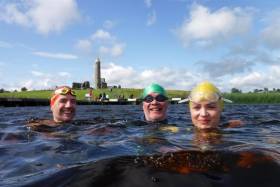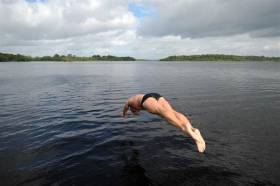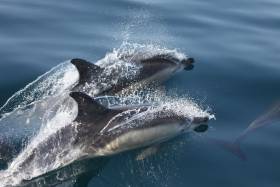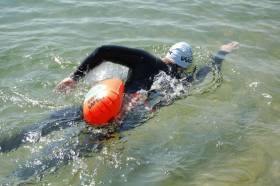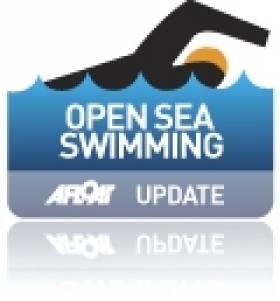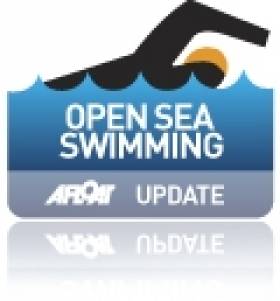Displaying items by tag: Open Water Swimming
Longest Day Swim Returns to River Corrib this Weekend
The “Longest Day Swim” on Galway’s river Corrib takes place this Saturday after a two–year break due to Covid-19.
North American Olympic gold medallist Joseph “Gunnar” Bentz has been invited to lead the event on July 2nd.
Bentz won two gold and two bronze medals at the FINA World Junior swimming championships, and holds silver and bronze medals from the Pan American Games.
Two courses – four km and 2.5km – have been set from Glenlo Abbey and Dangan, with both finishing at Steamer’s quay, Woodquay, in Galway city.
Galway Swimming Club (GSC) is hosting the event, with funds going to the young people’s mental health charity, Jigsaw.
The timed river swim is open to competent open water swimmers who must be over 18, and must be members of Swim Ireland for insurance purposes.
. “We’re delighted to bring back the Longest Day Swim and to promote the physical and mental health benefits of swimming,” GSC chairman Mark Gibbs has said.
“I’m particularly happy to welcome Jigsaw on board as our charity of choice this year.”
Places are said to be “filling up fast” and more details are here
The Fingal Swim Fest on north Dublin’s Donabate/Portrane peninsula and Mayo’s River Moy Swim are among events taking place in June for Swim Ireland’s new open water programme.
The Enniscrone Pier swim in Sligo on July 3rd, Youghal Swim Fest on July 10th, and events in Loughrea, Co Galway, Belmullet, Co Mayo and in Rathmullan, Co Donegal during the month of August are also planned.
The Lough Key Swim Fest rounds off the summer season on September 10th as part of an open water programme focused on “getting out, being active and completing your own personal challenge”, Swim Ireland says.
“Some have a competitive element and prizes, but we welcome those who also want to take it at their own pace,” it says.
Registration is now open, and prices for challenge and competitive events are between 10 and 45 euros, with a five euro discount for Swim Ireland members.
“Swiminkids” events are 8 euro per participant.
Swim Ireland says those taking part can choose” wetsuit, or no wetsuit”, and “for all events, you have the option of wearing a tow-float to help you feel that bit more confident”.
“There is something for everyone from short non-competitive participation events to longer competitive swims for those looking for a challenge,” it says.
The longer events are also suitable for those who like to swim at their own pace, it says.
More details on dates, locations and registration is here
Sea Pursuits Boosted by Pandemic
If there is an ill wind that doesn’t blow some good, it is the numbers taking to the sea and inland waterways during Covid-19.
As The Sunday Times reports today, this season has been the busiest ever for outdoor pursuit providers.
Eileen Murphy of Shearwater Sea Kayaking in north Dublin says her courses are booked out to the end of November.
“We didn’t resume fully after the lockdown until June, as our courses were for regulars in May, but we have never been busier,” Murphy says.
“I know the pandemic has been really tough and hard on people, but the one bright spark has been the number of people who have discovered their coastline – whether it be the Inishkeas off Mayo or Inishmurray off Sligo or Cork’s Roaringwater Bay,” she says
Record numbers have taken up open water swimming – both on the coast and in inland waterways – and many are expected to extend the activity into the winter, once Covid 19 travel restrictions permit.
Open water swimming
Miriam Coleman has been a regular sea swimmer for the past 12 years and says she would find joy in a “puddle” - but loves the ladies bathing shelter at Clontarf.
“You might regret not getting in, but you never regret getting in,” Coleman, who swims year-round, explains.
In Galway, the annual Frances Thornton Memorial Swim, held in aid of Cancer Care West, attracting large numbers for a “virtual” swim where participants could complete a 13 km distance in their own time during August.
Some 450 of over 500 entrants in Ireland and across the world raised €170,000 for Cancer Care West, a substantial increase on their normal anticipated figure for the event.
Surfing, paddle-boarding and windsurfing normally continue over the winter month, but their popularity will be boosted by a new film - not yet released -which recently won an award at the Portuguese Surf Film Festival.
 Elisabeth Clyne, Shauna Ward and Katie McAnena
Elisabeth Clyne, Shauna Ward and Katie McAnena
Elizabeth Clyne, Katie McAnena and Shauna Ward - all based in the north-west, have been profiled in a 12-minute documentary entitled Ebb and Flow made by photographer Alice Ward.
Ward, a Dubliner, was always a sea swimmer. During lockdown, her long-distance swimming dad John introduced several neighbours – Jen Faherty and Billy Hann - to its delights, and they swam 12 km from Lambay island to Balscadden beach in Howth in July.
The three women interviewed by Ward for her film describe how the cold water environment can “reset” their system, both physically and mentally.
McAnena, a Sligo-based GP from Galway, windsurfed “Jaws”, the big wave surfing break at Pe’ahi in Hawaii back in 2013. Her husband, Finn Mullen, had surfed it several years previously.
Last January, the couple were among five people to windsurf a record wave at Mullaghmore. McAnena, the first woman, was captured on film by videographer Clem McInerney.
Former Army Ranger Henry O’Donnell is currently attempting the first solo fin swim around Ireland for Water Safety Ireland and the Irish Cancer Society
 Former Army Ranger Henry O'Donnell who is swimming around Ireland for Water Safety Ireland and the Irish Cancer Society Photo: Rory O’Donnell
Former Army Ranger Henry O'Donnell who is swimming around Ireland for Water Safety Ireland and the Irish Cancer Society Photo: Rory O’Donnell
“I’m at this 52 years, and I feel at home in the water, but it doesn’t have to be a big climb to enjoy it,” he says.
“People don’t even have to join a club – the pods of dolphins around the coast are also now pods of swimmers, and one just has to be aware of safety.”
Water safety
Water Safety Ireland’s highly informative website has safety tips and advice for open water swimming, including never swimming alone, very gradual acclimatisation to colder temperatures, risks of cold water shock – and emphasis on checking tides and weather. Download WSI safety advice on the PDF below.
Read more in The Sunday Times here
#Swimming - A number of novice open water swimmers will be taking part in a major event on Lough Erne this weekend.
The past 10 weeks have seen 20 people taking part in the Couch to 5km Challenge on Lough Erne, as previously reported on Afloat.ie.
Coached by Maureen McCoy and Paul McCambridge, the course has been aimed at swimmers of various levels who wanted to either start swimming outdoors or improve their fitness and speed for events.
Starting in June, the swimmers were taken for their introduction to open water in the relative security of the calm bay at the Share Centre in Lisnaskea.
Now, after developing their skills, swim technique and endurance, the swimmers will complete the course and test themselves in the Irish Long Distance Swimming Association’’s National Open Water Swim on Lough Erne tomorrow (Saturday 5 August).
Some of them will be taking on the 1,500m swim while even more will be braving the 5km swim.
Couch To 5K Open Water Swim Challenge Comes To Lough Erne
#Swimming - Waterways Ireland has welcomed Maureen McCoy and Paul McCambridge’s efforts to bring their Couch to 5K Swim Challenge to Lough Erne.
The 10-week programme is designed to bring swimmers out of the pool and into the open water. The scheme will run over five fortnightly sessions from June to August 2017 and will provide swimmers with the knowledge, skills and training to ultimately complete a 5km swim event.
The coaches are Maureen McCoy, an English Channel soloist, and Paul McCambridge a North Channel relay swimmer. Both Maureen and Paul will guide swimmers through from the first outdoor swim to competing in this challenging event.
The Couch to 5K Swim Challenge is aimed at swimmers of varied levels who wish to either start swimming outdoors or improve their fitness and speed for events. The coaches have designed a programme that will challenge each swimmer and allow them to acquire new skills, no matter what their starting point.
The five fortnightly sessions will take place on Saturdays starting on 3 June, and will increase in intensity with the aim of completing a 5km swim in August.
There is a fee of £30 for participation. Register your interest at [email protected] or wildswim.wordpress.com.
Carlingford To Host European Championships For Global Swim Series
#Swimming - Carlingford in Co Louth is the venue for the Global Swim Series European Championships on Saturday 15 October.
Ireland has already hosted 14 races in the international league for open water swimming, which included the legendary Liffey Swim and more recently the Dun Laoghaire Harbour Race.
So it should come as no surprise that Irish swimmers — and in particular swimmers from Northern Ireland — are topping the series leaderboards heading into Carlingford Lough’s first hosting of the European Championships in less than two weeks’ time.
The event also marks the point where racing moves to the Southern Hemisphere and swimmers in Australia, New Zealand, Brazil, the Philippines and the Pacific islands set their sights on the top of the table before the series concludes next April.
Seascapes Podcast: Glandore Classic Boat Summer School, Sailing in West Cork, SmartBay & Open Water Swimming
Hello and welcome aboard this week’s edition of your maritime programme Seascapes – this week we talk to sailing instructor and yachtsman Niall McAllister in Adrigole in West Cork; we have music from Eleanor Shanley and “Sail Away To The Sea”; we preview the Glandore Classic Boat Summer School, we have the second part of our conversation with John Breslin of SmartBay on how he became involved in the maritime world.............. first on Seascapes this week we talk to Open Water swimmer and Steve McQueen fan Ned Denison on the Open Water Swimming calendar and a unique swim in the Southern Hemisphere.......
Ned Denison and Open Water Swimming and that extraordinary swim around Devils Island....the Vibes and Scribes Lee Swim takes place on next Saturday 16th July ..
Originally held in 1914, the annual Vibes and Scribes Lee Swim has become one of the top open water swimming events in Ireland. The course runs through the centre of Cork City, with a distance of around 2 kilometres (1,700m downstream and 300m upstream).
Starting from a specially erected platform at the entrance of the old distillery premises on the North Mall, the contestants swim under all the bridges of the North Channel with the flow of the River Lee until they round the Port of Cork Customs House. They will then continue against the flow of the river to the finishing pontoon in front of the Clarion Hotel.
Most of the swimmers compete for age group prizes, some raise money for local charities and a good number just swim for the enjoyment of the day and the acknowledgement and encouragement of family and friends.......
Congratulations to all in Clontarf Yacht and Boat Club on the completion of the IDRA 14 class wooden dinghy – named “Wicked Sadie” and launched on the last Sunday in June, congratulations to all involved lead by Ronan Melling ...Bravo...
Last week here on Seascapes we talked to John Breslin of Smart Bay well while we were discussing the observatory in Galway Bay and the new technologies that it harnesses we wondered how he became involved in the maritime world .........
John Breslin on the exciting world of technology and the marine and the Smart Bay Observatory ....next week here on Seascapes we’ll hear about a new SeaScience App developed by the Ryan Institute at NUI Galway.....we’ll be talking to Martina Prendergast
........well from Galway to the Glandore Classic Boat Summer School which is on next weekend on Saturday 16th we have all the details on the Seascapes webpage..... speakers include Rui Ferreira, Oliver Hart, Donal Hayes, Dr.Breda Kenny, Dr Charles Luddington, Padraig Whooley, Gary McMahon, John O’Connell, Simon O’Keeffe, Vincent O’Shea, Tiernan Roe, Bill Trafford and others.
Next here on Seascapes to Adrigole in West Cork and sailing instructor , mariner and yachtsman Niall McAllister from the West Cork Sailing and Powerboat Centre .....Niall told us how he became involved and about “Jessy” his Sun Odyssey 37 ....
Warning Over Dangers Of Open Water Swimming
#Swimming - Waterways Ireland advises anyone engaged in open water swimming training of the inherent dangers attached to this activity in locations where there is boating traffic.
A swimmer in the water wearing high visibility head gear will always remain a very small target to see to the master of a powered craft, particularly if:
- The water surface is choppy.
- There is strong glare reflected from the water surface.
- There is difficulty in sighting due to slanting sunshine in early morning or late evening.
- Visibility is poor due to fog, mist or rain.
Swimmers should risk assess their swimming location prior to entering the water, for boat traffic, entry and exit locations, availability of life saving appliances, weather and water conditions.
The presence of a safety boat or kayak will always give enhanced safety and security.
Dubliner Is First To Swim From Kish Lighthouse To Shore
#OpenWaterSwimming - H2Open magazine reports on last week's successful swim from Kish Lighthouse to the Forty Foot by Dublin open water swimmer Gary Fitzgerald - the first person to swim the 12km route.
The 24-year-old took on the challenge in memory of his late former manager and friend Arthur Dunne of the Half Moon Swimming and Water Polo Club, who had dreamed of swimming the route before his untimely death at the age of just 42.
Gary was cheered on during his attempt on 27 September by his brother Mark and father Dave, himself a top swimmer and former national coach in water polo, as well as pioneering Channel swimmer Shane Moraghan, while Fergal Somerville - who swam the North Channel for charity this summer - served as independent observer.
Corkman Is Open Sea Swimming's Man Of The Year
#Swimming - Cork swimmer Steve Redmond has been named World Open Water Swimming's Man of the Year for 2012 for his record-breaking triumph in the Oceans7 Challenge last summer.
As the Southern Star declares: "Few individuals in the history of open water swimming have carried the heavy physical, mental, emotional and financial burdens that Stephen Redmond heaped upon his broad shoulders in 2012."
It marked the third year in a row that Redmond was nominated for the international award.
The Corkman had already conquered many of the world's toughest marathon swims - such as becoming the first person ever to swim from Baltimore to Schull around the Fastnet Rock - before setting sights on the Oceans7 Challenge, the open sea swimming equivalent of climbing the world's seven highest peaks.
As previously reported on Afloat.ie, he completed the final leg of the challenge when he crossed Japan's Tsugaru Strait in mid July, beating Australian marathon swimmer Penny Palfrey to the coveted accolade.



























